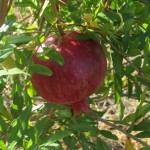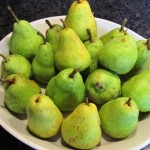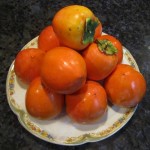The Fall “P” Fruits Are Ripening on the Farmette
Our pears, persimmons, and pomegranates hang heavy on the trees now. This despite the scorching summer we’ve had and the lack of rain. Water restrictions have made it doubly difficult for the fruits of these trees to reach their full potential.

Ripe pomegranates have a leathery outer skin, membranes thicker than oranges, but sweet, juicy seeds inside
The squirrels and raccoons have been munching on the late summer pears. Yesterday, I stripped most of the fruit off and placed in paper bags in the kitchen cabinet. In two to three days, the pears will reach the perfect ripeness for eating fresh.
Fuju and hachiya persimmons are taking on color and should be ripe and ready to eat in about a month. I’ve been working hard to save the trees that are suffering from California’s extreme drought.
A spokesman for one Bay Area water resource board suggested we gardeners let our ornamental plants like roses and other flowers go while we try to save our trees. A hard thing for me to do. Praying for rain, we hold out hope that next year’s climate will be better for backyard gardeners and growers.
______________________________________________________________________________
Interested in backyard gardening topics like keeping chickens and bees or growing heirloom vegetables? Check out my cozy mystery series from Kensington. The stories are informed by my work on the farmette I’ve been restoring for a dozen years. Find all Meera Lester books on Amazon.com, Barnesandnoble.com, and everywhere books are sold online or in brick and mortar stores.
Beeline to Murder features a former cop who keeps bees
and sells lavender honey to her town’s celebrity chef . . . until
she finds him dead.

The town of Las Flores is abuzz with the news of the death of a free spirit who has secrets in her background and ties to a local nudist camp.

The renewal of wedding vows ends on the steps of the church with the outburst of a local woman intent on revenge. The husband is soon found dead but the obvious suspect may not be the culprit at all.
Buying Fair Trade Generates More than Good Taste
We all love our local farmers’ markets where the freshest organic ingredients–direct from the farm to our tables–are easy to find and purchase. And they taste so good. But sometimes, we consumers desire something grown beyond America’s borders, such as tea, coffee, exotic spices, and chocolate. And this is where choice and purchasing power has consequences.
When you choose to buy products displaying a FAIR TRADE certification logo, your action directly and positively impacts the lives of farmers, growers, artisan craftspeople, commodities producers, and their workers in communities in developing nations.
As consumers demand better products and better working conditions for workers, the Fair Trade movement has more clout to lobby on behalf of commodity farmers, impoverished workers, and child laborers.
If you love chocolate, consider this: seventy percent of the world’s cocoa beans is produced in Cote d’Ivoire and other Western African countries. Pay is nominal at $2 USD/per dieum and, according to UNICEF, more than a half million children labor under dire working conditions in the cocoa fields in these bean-producing countries even though child labor is illegal in the cocoa industry.
Coffee was one of the first Fair Trade certified products but today’s consumers can now also find Fair Trade certified cocoa, wine, cotton, fruit, tea, red palm oil, coconut oil and associated products, chocolate, honey, quinoa and other ancient grains, beans, sugar, and bananas, to name a few items.
The Fair Trade Movement has been around since mid last century. It began as a mainly North American/European social movement to aid poor farmers, commodity producers, and laborers in developing nations to achieve more favorable trading conditions. Fair Trade also promotes sustainability.
Choosing to buy a product carrying the Fair Trade certification label means your consumer decision will impact more than your taste buds–it will have positive ramifications for workers, commodity producers, and their communities beyond America’s borders.
 Facebook
Facebook Goodreads
Goodreads LinkedIn
LinkedIn Meera Lester
Meera Lester Twitter
Twitter





